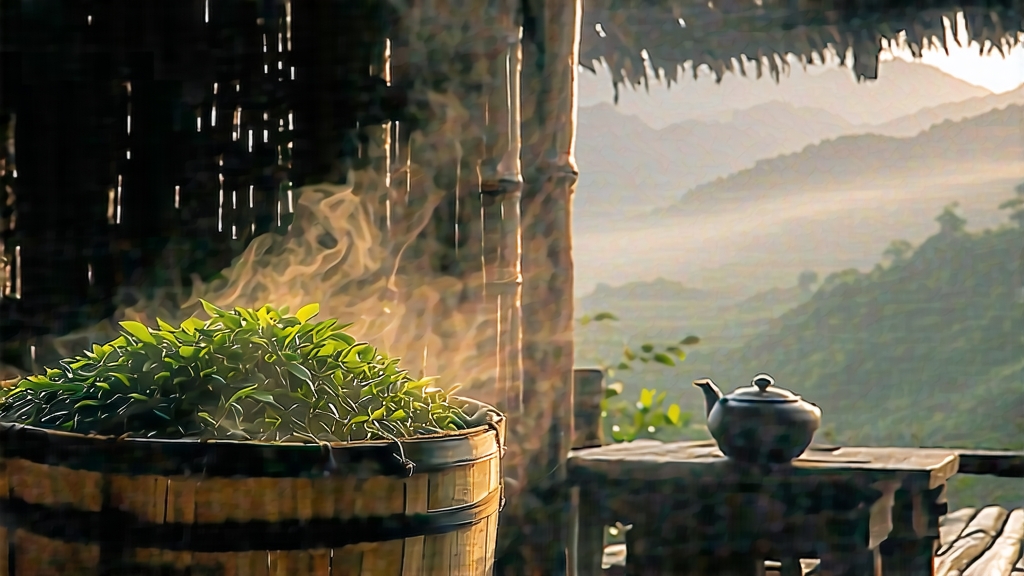
Tucked away in the humid, karst-pitted mountains of southern China, the city of Wuzhou in Guangxi Province guards a tea secret that even many Chinese connoisseurs have never tasted: Liupao, a dark, lustrous leaf that ferments twice—once in pile and once again inside tight bamboo baskets—until it smells faintly of betel nut, damp earth, and long-forgotten incense. To international drinkers who know only Pu-erh, Liupao offers a quieter, more camphorous path into the world of post-fermented tea, a path that begins in the Qing-era docks of the Xun River and ends in your teacup with a ruby liquor as clear as a monk’s gaze.
Historical currents
The name “Liupao” literally means “six fortresses,” a reference to the six customs checkpoints that once taxed tea barges heading south toward Guangdong and, eventually, Southeast Asia. Commerce records from 1796 show that Liupao was already being pressed into 40-kilogram baskets, loaded onto bamboo rafts, and floated downriver to Guangzhou’s Thirteen Factories for export to Malaya, where tin miners drank it to ward off malaria and homesickness. Because the journey took weeks under tropical humidity, the tea continued to ferment inside the baskets, acquiring the mellow, medicinal character that became its signature. When the Suez Canal opened in 1869, Liupao reached London docks labeled “China Black Tea, Basket Aged,” where it was blended into sturdy breakfast bricks for dockworkers who wanted something darker than Assam but cheaper than Keemun. Thus, long before the concept of “post-fermentation” entered tea lexicons, Liupao was a living demonstration of terroir plus travel.
Micro-terroir and leaf material
Guangxi’s low-latitude hills sit just inside the Tropic of Cancer; summer air feels like breathing through a warm towel, and winter brings only a polite chill. The native tea population here is a large-leaf Assamica variant locally called “Qunti,” interplanted with camphor and cinnamon trees whose roots share mycorrhizal fungi with the tea bushes. These fungi contribute subtle woody notes that later amplify during fermentation. Farmers pick one bud plus the fourth or fifth leaf—older, tougher foliage packed with polysaccharides that microbes love to convert into soluble sugars and amino acids. The result is a leaf that looks too coarse for green tea but perfect for the long microbial journey ahead.
Crafting Liupao: the double dance of water and fire
Although classified as a hei cha (dark tea), Liupao’s production calendar resembles a theatrical play in four acts, each named after the local dialect rather than textbook terms.
Act I: Qing Huang—“killing the yellow.” The picked leaves are spread 5 cm thick on bamboo trays and withered under mountain mist for four hours, then plunged into a wok heated to 280 °C for exactly 240 seconds. The goal is not full de-enzyming as in green tea; instead, growers leave a whisper of oxidative vigor that will seed later microbial blooms.
Act II: Men Dui—“the sultry pile.” The half-fixed leaves are piled 70 cm high inside a pine-sided room whose floor is sprinkled with mineral-rich well water. Temperature probes are inserted like acupuncture needles; when the core hits 55 °C, workers “fan” the pile—turning it by hand while spraying a mist of water infused with the previous year’s Liupao liquor, a starter culture akin to sourdough. This phase lasts 18–22 days and is where the tea earns its dark cloak: chlorophyll breaks into pheophytin, catechins polymerize into theaflavins and thearubigins, and a bloom of Eurotium cristatum (the same golden “golden flower” seen on Fu bricks) appears as tiny yellow freckles.
Act III: Liang Lan—“cooling in orchid baskets.” The pile is dismantled and the leaves sun-dried for one day, then transferred to cylindrical bamboo baskets lined with wild orchid leaves that impart a faint floral note. Here the tea rests for three months, losing grassy odors while absorbing orchid and bamboo volatiles.
Act IV: Chen Hua—“the slow bloom.” The semi-finished tea is steamed for 90 seconds to soften, then packed tightly into 30